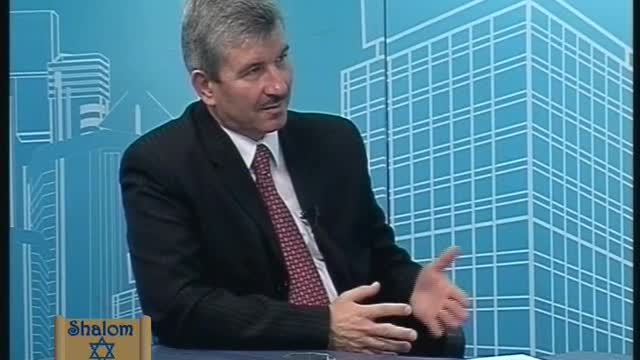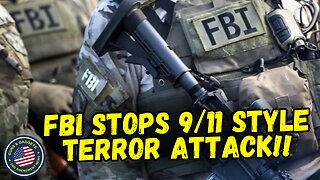Premium Only Content

Shalom Israel - Iosif Klein Medesan Jurnalist - 12 Statul Israel
Shalom Israel
O emisiune despre Istoria, Cultura si Religia poporului Israel
Emisiunea 12 - Statul Israel
Invitat: Iosif Klein Medesan, Editor General Romania Libera
Moderator: Pastor Ioan Peia
Un ciclu continuu al razboiului si pacii, al violentei si coexistentei
Care sunt bataliile trecutului si care sunt sperantele viitorului?
Un scriitor ceh a definit ce inseamna o natiune mica: „Este acea natiune a carei existenta poate fi pusa sub semnul intrebarii in orice moment. O natiune mica poate dispare si ea stie lucrul acesta.”
Israelul este o natiune mica. De patru ori in ultimii 60 de ani a fost fortata sa lupte in razboaie pe care nu-si putea permite sa le piarda. Alternativa la victorie era un singura, exterminarea totala..
Din clipa in care a fost delcarata infiintarea noului stat Israel sase natiuni vecine – Egiptul, Siria, Jordania, Libanul, Iraqul si Arabia Saudita au declarat razboi pentru distrugerea totala. Uimitor insa micul David a birut in fata uriasilor.
Ne bucuram sa avem in studioul nostru pe Domnul Iosif Klein Medesd, editor general la ziarul Romania Libera.
Domnule Klein ce s-a intamplat dupa ce liderul spiritual al musulmanilor din Palestina a spus: „Declar razboiul sfant frati musulmani. Ucideti evreii! Omorati-i pe toti!”
Cat a durat razboiul de independenta? (15 luni)
Cate victime au fost de partea Israelului? (6000)
Statele arabe au refuzat recunoasterea statului Israel. Atacurile teroriste non stop.
1956 campania din Sinai – retragere sub presiunea internationala.
1967 Gamal Abdel Nasser inchide stramtoarea Tiran, „un prim pas in programul de exterminare a sionistilor si inecarea evreilor in mare.”
Razboiul de 6 zile
De ce est atat de faimos acest razboi?
Israelul o mare putere militara?
Ce au gasit soldatii evrei in Ierusalim? (sinagogi desacrate sau distrusae, cimitirele vandalizate)
La zidul plangerii?
Midrash spune ca: „Totul pe Muntele Templului a fost construit prin contributia evreilor bogati. Atunci saraci au cerut sa contribuie si ei la frumusetea Casei lui Dumnezeu. Banii stransi cu truda au fost folositi la constructia Zidului de Vest. De aceea nu poate fi distrus pentru ca a fost zidit cu mare sacrificiu.”
De ce a cedat Moshe Dayan controlul Muntelui Templului in mainile waqf (trustul caritabil care are grija de locurile sfinte ale musulmanilor pe Muntele Templului)? Dayan a vrut sa arate ca evreii sunt gata sa plateasca mult de dragul pacii.
De ce evreii si crestinii nu se pot ruga pe Muntele Templului?
Razboiul de Yom Kipur
De ce au ales arabii ziua de Yom Kipur pentru a ataca Israelul?
Ei au crezut ca evreii vor fi toti ocupati cu sarbatoarea si postul. Dar drumurile erau libere si din spusele unui combatant care mi-a impartasit direct de s-a intamplat, evreii toti stiau ca razboilul poate incepe dintr-o clipa in alta. De aceea nu au fost luati prin surprindere.
Cat de dramatic a fost acest razboi? Cand au intervenit Natiunile Unite?
Cand evreii erau aproape sa piarda razboiul UN a tacut. Cad evreii au devenit biruitori toti sau strigat pentru incetarea focului.
2700 de pierderi omenesti.
Pace contra teritoriilor?
Peninsula Sinai contra relatiilor diplomatice cu Egiptul. Saadat in Ierusalim 1976
Primul razboi din Liban
Invasion
On 6 June 1982, Israeli forces under direction of Defense Minister Ariel Sharon invaded southern Lebanon in "Operation Peace of the Galilee".
Course of the fighting
Israeli troops in South Lebanon, June, 1982
Israel's publicly stated objective was to push PLO forces back 40 kilometres (25 mi) to the north. Israeli forces pushed in from Southern Lebanon. After several battles, they soon reached that target but were determined to drive the PLO from southern Lebanon.[26] Tyre and Sidon (major cities in South Lebanon, still within the 40-kilometre (25 mi) limit) were heavily damaged, and the Lebanese capital Beirut was shelled for ten weeks, killing both PLO members and civilians.
The Israeli Air Force shot down 86 Syrian aircraft, with no air combat losses of its own. This was the largest combat of the jet age with 150 fighters from both sides.[27] It also performed ground attacks, notably destroying the majority of Syrian anti-aircraft batteries stationed in Lebanon. AH-1 Cobra helicopter gunships were used widely against Syrian armor and fortifications. The IAF Cobras destroyed dozens of Syrian armored fighting vehicles, including some of the modern Soviet T-72 main battle tanks.
An agreement was reached later in 1982, and American, French, and Italian peacekeepers, known as the Multinational Force in Lebanon, sent more than 14,000 PLO combatants out of the country in August and September. About 6,500 Fatah fighters sailed from Beirut to Jordan, Syria, Iraq, Sudan, both North and South Yemen, Greece, and Tunisia — the latter of which became the new PLO headquarters.[28] Philip Habib, Ronald Reagan's envoy to Lebanon, provided an undertaking (i.e., assurance) to the PLO that the Palestinian civilians in the refugee camps would not be harmed. However, the United States Marines left West Beirut two weeks before the end of their official mandate following the 1983 Beirut barracks bombing.
On 14 September 1982, Bashir Gemayel, the newly appointed President of Lebanon, was assassinated. Israeli forces occupied West Beirut the next day, in violation of the Habib agreement. At that time, the Lebanese Christian Militia, also known as the Phalangists, were allied with Israel.[29] The Israeli command authorized the entrance of a force of approximately 150 Phalangist fighters' into the Sabra and Shatila refugee camps, claiming there was a remaining force of approximately "2000 PLO terrorists" in the camps.[29][30] The result was the Sabra and Shatila Massacre in which at least 800 civilians were slaughtered by the Phalangists, who themselves suffered only two casualties. Meanwhile, Israeli troops surrounded the camps with tanks and checkpoints, monitoring entrances and exits.[29] Further Israeli investigation by the Kahan Commission of Inquiry found that Ariel Sharon bears "personal responsibility" for failing to prevent the massacre, and for failing to act once he learned that a massacre had started, and recommended that he be removed as Defense Minister and that he never hold a position in any future Israeli government. Sharon initially ignored the call to resign, but after the death of an anti-war protester following an anti-war protest, he did resign as Israel's Defense Minister, however, he remained in Begin's cabinet as a Minister without portfolio. He later became Prime Minister of Israel.[29]
Casualties
It is estimated that around 17,825 Lebanese were killed during the war, with differing estimates of the proportion of civilians killed. Beirut newspaper An Nahar estimated that 5,515 people, both military and civilian, were killed in the Beirut area alone during the conflict, while 9,797 military personnel (PLO, Syrian, and others) and 2,513 civilians were killed outside of the Beirut area.[31] Approximately 675 Israeli soldiers were killed.
The security buffer zone
In September 1982, the PLO withdrew most of its forces from Lebanon. With U.S. assistance, Israel and Lebanon reached an accord in May 1983 that set the stage to withdraw Israeli forces from Lebanon while letting them patrol a "security zone" together with the Lebanese Army.
The instruments of ratification were never exchanged, however, and in March 1984, under pressure from Syria, Lebanon canceled the agreement.
In January 1985, Israel started to withdraw most of its troops, leaving a small residual Israeli force and an Israeli-supported militia in southern Lebanon in a "security zone", which Israel considered a necessary buffer against attacks on its northern territory. The Israeli withdrawal to the security zone ended in June 1985.
Scuduri pentru Israel! 1991 De ce din nou Israelul este atacat?
Intifada solutia PLO – Yassir Arafat. (Razboiul pietrelor)
Yitzhak Rabin, Shimon Peres si Yiasir Arafat Premiul Nobel pentru Pace in 1993
Arafat nu a implinit nici un acord pe care l-a semnat in timpul vietii lui.
Dupa Oslo el declara la Bethlehem: Noi stim un singur cuvant: jihad, jihad, jihad – razboiul sfant
In iulie 2000 Ehud Barak era gata sa dea palestinienilor aproape totul contra pacii: Israelul se retragea din 97% din West Bank, ceda estul Ierusalimului, recunostea statul palestinian cu capitala la Ierusalim.
Dar in mod inexplicabil Arafat respinge oferta evreilor si americanilor. Violenta si terorismul a fost prea mult timp singurul lui mod de a opera si nu se putea schimba.
Din ordinul lui Arafat o noua intifada incepe in septembrie 2000.
Retragerea din Gaza si iesirea din scena vietii politice a lui Ariel Sharon
Al Doilea Razboi din Liban. 2006 Rachete Grad si Katiusha
Razboiul din Gaza si opinia publica internationala.
Amenintarea Iranului si rezolvarea unei situatii care poate parea fara solutie.
Al Treilea Raboi Mondial?
Primii 60 de ani de axistenta a noului stat Israel au fost marcati de numeroase razboaie, reflectand refuzul tarilor arabe de a accepta existanta Israelului.
Acordul de la Oslo oferea posibilitatea sfarsitului ostilitatilor arabo - israeliene, dar a fost declarat mort dupa refuzul lui Arafat de la Camp David din 2000.
Chiar daca Israelul trebuie sa faca fata unor probleme deosebit de dificile, realizarile de pana acum ne fac sa credem ca poporul Cartii va continua sa existe si sa prospere in Tara Promisa.
Domnule Klein va multumim pentru participarea la emisiunea noastra.
Shalom Israel!
-
 2:32:28
2:32:28
Matt Kohrs
12 hours agoBitcoin Falters, Degen Psychology & Breaking News || The MK Show
32.7K2 -
 38:23
38:23
BonginoReport
4 hours agoJack Smith Belongs Behind Bars (Ep.93) - 11/26/24
74.8K129 -
 LIVE
LIVE
Clownfish TV
2 days agoClownfish TV News 24/7
210 watching -
 1:01:35
1:01:35
2 MIKES LIVE
1 hour agoThe Mike Schwartz Show 11-26-2024
24K1 -
 1:32:51
1:32:51
Game On!
11 hours ago $10.78 earnedThe NFL has an officiating problem after the WORST MNF game of all time!
92.7K11 -
 1:11:52
1:11:52
LFA TV
13 hours agoDebt Tuesday: Trump: More Tariffs on Canada, Mexico, China | WORLD HD 11.26.24 @8am EST
54.6K4 -
 1:05:00
1:05:00
Part Of The Problem
14 hours agoDave Smith | Trust the Science | Part Of The Problem 1196
92.2K39 -
 13:58
13:58
Tactical Advisor
19 hours agoBudget vs Expensive Shotgun
56.9K12 -
 14:19
14:19
justintech
15 hours ago $3.89 earnedBest Gaming PC Under $2000 - In 2024
35.9K7 -
 5:09
5:09
Guns & Gadgets 2nd Amendment News
1 day agoFBI Stops 9/11 Style Terror Attack!!
49.8K28